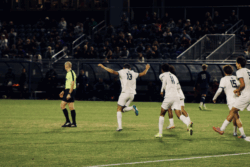A runner’s pre-race routine typically includes a quick shoe and uniform check. For Aimee Mullins (SFS ’98), the standard list included one more item: her legs.
In 1996, Mullins qualified for the 100- and 200-meter races in the Big East Championships. Like the rest of her competitors in the 100-meters, Mullins lined up at the starting line, waited for the gun to sound, and sprung into action as soon as the signal crackled through the air. About 80 meters into the race, however, Mullins’s right leg slipped off, and she crashed to the ground.
Unlike the rest of her “able”-bodied competitors, Mullins was born without fibula bones and had her legs amputated from the knee down right after she was born, forcing her to wear prosthetics for the rest of her life. Instead of letting her disability stop her, Mullins now runs and walks on custom-made carbon graphite legs formed in the shape akin to that of a cheetah’s hind leg. Though her prosthetic legs have carried Mullins on an extraordinary life journey, her Big East racing trauma looms large in her mind.
It was only after the encouragement of then-Hoya track coach Frank Gagliano that Mullins put her leg back on that day in ‘96, returned to the starting line, and competed in the 200-meter race. Sometimes, coach knows best.
“It was kind of like my worst nightmare, to be in public knowing that it was very possible that my leg could come off again,” Mullins said. “It was one of those kind of epic moments, that after the fact you realize that you just kind of crossed the threshold into a different level of maturity because you faced this profound, deep-seated childhood fear.”
Mullins decided to compete in sports early in her life and never doubted her choice. Whether skiing, playing softball, or swimming, she felt a natural urge to compete.
“I think every single one of us has to have that moment of reckoning with themselves and ask, ‘Are you living the life you want to? Or are you accepting what comes your way passively?’”
Mullins’s athletic experience hadn’t included track before she came to Georgetown. In fact, she had never run competitively before her freshman year until she decided to enter a meet open to other amputees. When she showed up, she noticed she was the only runner with wooden legs—everyone else had carbon graphite legs. Unfazed, Mullins won the race and soon after persuaded Gagliano to let her train with the track team. Eventually, Gagliano decided that Mullins was good enough to run with the Hoya women’s track and field teams. Once a team member, Mullins was immediately “taken into the fold, supported, and loved” by the program and the Georgetown community.
“Being up on the Hilltop, just the smell of that track up there, and the observatory, and the sunset going down over the Potomac—I felt incredibly fortunate to have the ability to put on a uniform for that school.”
Without a doubt, it was Mullins’s indomitable desire to act that made her foray into the world of track and field possible.
“I have no problem with you if you have a complaint about resistances in your life, as long as that complaint is the catalyst to make you do something about it,” Mullins said.
Mullins took her track and field experience into the 1996 Paralympics in Atlanta, where she set world records in the 100m, 200m, and long jump. Though her athletic achievements are impressive, they only tell a part of Mullins’s story.
These days, Mullins is making an even bigger impact on the world. In February, she gave her second TED (Technology Entertainment Design) Talk, providing her the enviable opportunity to speak about the design and technology of the twelve different types of legs she owns—some are for running, some are for cross-training, and some are for every-day living situations. Mullins has also entered the fashion and entertainment worlds, appearing in magazines such as Vogue, Glamour, and Elle, and acting in one of contemporary artist Matt Barney’s films, Cremaster 3. Clearly, Mullins’ journey is far from typical.
“Traditionally, you hear a story about who grew up without legs, and you say, ‘Ok, I know what that is … a tragedy, blah, blah, blah, I’m doing great, wow, isn’t it amazing.’ That’s not my story. My life was never a tragedy, and I never had to triumph over that,” she said.




